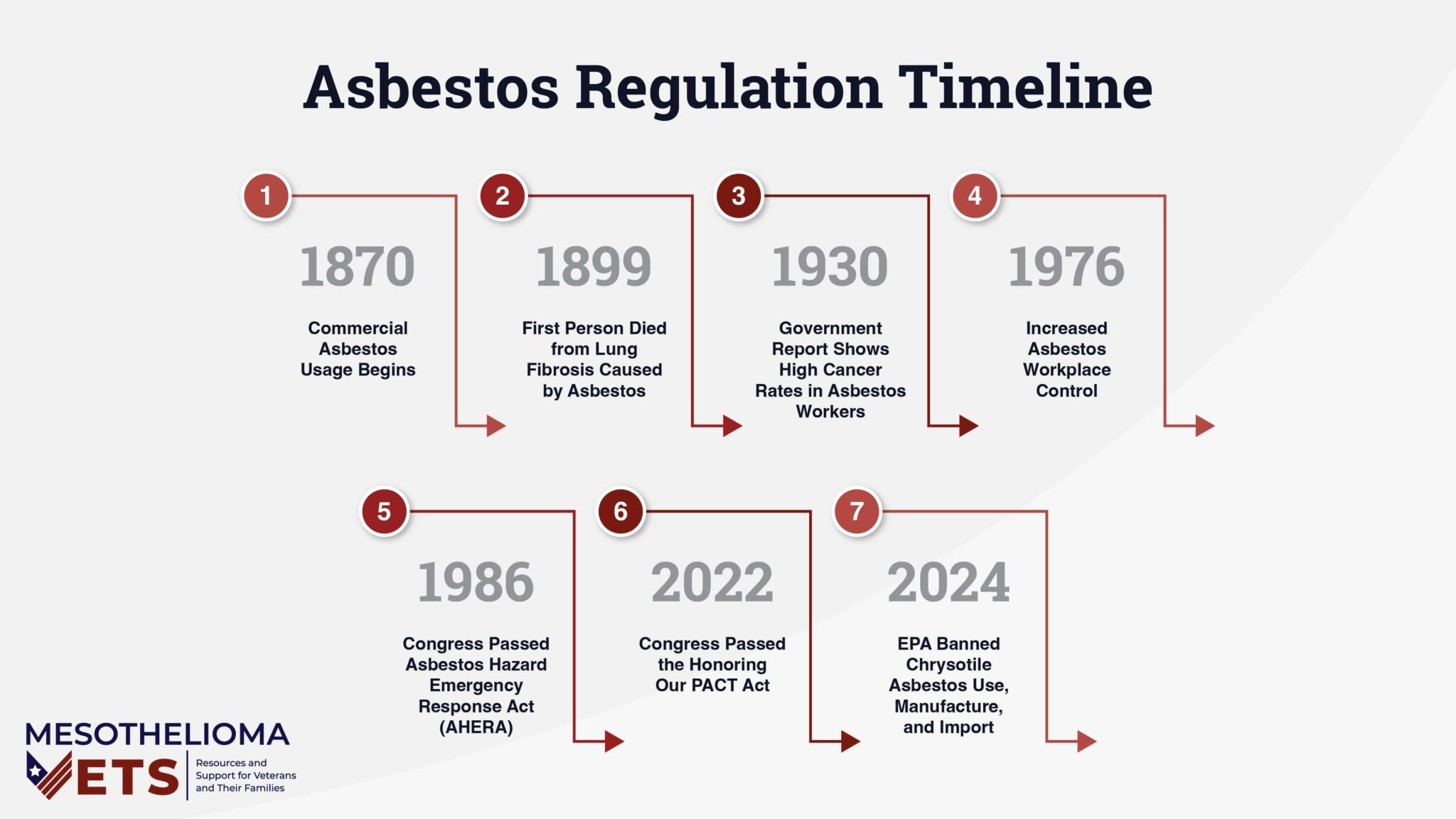When Was Asbestos Banned in the Military?
Before the 1980s, asbestos was used heavily by the U.S. military because of its cost efficiency, durability, and fire-proofing abilities. The military used the substance in every branch, exposing millions of servicemen and women, and civilians who came into close contact with it. Many veterans are actively being diagnosed with mesothelioma.

Why Should Asbestos Be Banned?
MARCH 2024 UPDATE: Asbestos was just banned by the FDA. Find out more at the link.
Asbestos is a fibrous mineral once mined and manufactured heavily in the United States and other parts of the world. With its heavy use in consumer and military property, many ask when asbestos was banned. Once considered a miracle, the carcinogen provided value in commercial industries, homes, school buildings, and the military.
Many everyday products can contain the mineral, including:
- Air duct coverings
- Automobile clutches and brakes
- Gutters
- Insulation
- Pipes
- Popcorn ceilings
- Roofing and siding shingles
- Textured paint
- Vinyl floor tile
Asbestos is dangerous because it may lead to a diagnosis of various cancers and diseases. When crumbled, the fibers create a dust cloud of microscopic fibers that exposed people may inhale or ingest.
Once asbestos enters the body, the fibers attach to a protective layer that lubricates the organs in the chest and abdomen, called the mesothelium. The lodged fibers can create friction against delicate organ tissues and eventually lead to the mutation of cells and the formation of mesothelioma.
Asbestos Use in the Military
All five branches of the military relied on asbestos and asbestos-containing products from the 1930s until the 1970s. The Environmental Protection Agency (EPA) first defined the mineral as a hazardous air pollutant in 1971 due to ongoing health concerns. Some military construction products, however, used the carcinogen in some products as late as 1991.
Air Force
The Air Force became a separate military branch during the widespread use of asbestos, resulting in the significant use of it. Air Force buildings and barracks contained the toxin in ceiling insulation, walls, floor tiles, aircraft brakes, engine valves, and gaskets. Jobs at risk for exposure included:
- Aircraft handler
- Electrical systems specialist
- Environmental systems specialist
- Fire control technician
- Mechanic
- Metalsmith
Army
Army buildings and vehicles contained the toxin throughout insulation, cement flooring, roof tiles, and plumbing. Aircraft mechanics, artillerymen, and vehicle mechanics are most at risk of developing mesothelioma.
Marine Corps
Marines came into contact in sleeping quarters, mess halls, boiler rooms, and engine rooms. Anywhere insulation and plumbing pipes were, the threat of asbestos exposure lived. Many Marines lived and worked close to Navy shipyards, which contained large amounts of the carcinogen.
Navy and Coast Guard
Navy and Coast Guard property contained the highest levels of asbestos in the military. Insulation, paint, and boiler and engine rooms on Navy ships all stored the substance. Each ship potentially exposed thousands of sailors and crew members. Most jobs in the Navy involved coming into contact with asbestos dust.
When Was Asbestos Banned?
Asbestos was first used to protect service members. Instead, veterans face a higher risk of developing asbestos-related cancer. The United States didn’t begin removing property that contained the carcinogen until the mid-to-late 1970s when lawmakers began to restrict it.
The United States and the EPA have not fully banned asbestos, though the mining of the material in the U.S. finally ended in 2002. While asbestos is a well-known carcinogen, there is currently no nationwide ban on asbestos.
The mineral is still imported and manufactured in products we use today. Some products that we all come into contact with may legally contain up to 1% of asbestos. These products can include automotive brake pads and clutch discs, roofing, ceiling and flooring materials, pipes and duct wraps, gaskets, valves, and hoses.
Regulation of Asbestos Use in the United States
1900s-1960s
There have been several studies connecting asbestos to diseases as early as 1918, but the general belief declared low levels of airborne asbestos fibers were non-cancerous. In 1951, Congress passed the Walsh-Healy Act, which recommended certain equipment can contain low levels of asbestos.
In 1960, Congress passed the Longshoremen’s Act. It created a threshold that considered certain fiber lengths dangerous but did not consider all forms and amounts of the mineral dangerous.
1970s
After the EPA’s formation, Congress passed the Clean Air Act in 1970, which finally declared all types of asbestos fibers to be toxic. The act allowed the EPA to establish the Asbestos National Emission Standards for Hazardous Air Pollutants (NESHAP) rules. The rules set exposure limits for asbestos fibers released into the air during the demolition or renovation of asbestos-containing buildings.
The Safe Drinking Water Act passed in 1974 allowed the EPA to regulate the nation’s public water supply, which enforced a national standard that drinking water is free of threats such as asbestos, pesticides, and other contaminants.
The Toxic Substances Control Act (TSCA) in 1976 allowed the EPA to regulate how asbestos-containing products were packaged, handled, stored, and disposed of, though it did not ban the toxin.
In 1976, the National Institute for Occupational Safety and Health (NIOSH) recommended a ban on asbestos in the workplace. Though the recommendation did not result in a ban, the use of the carcinogen began declining as a result.
1980s-1990s
Congress passed the Asbestos Information Act in 1986. The act required producers to report the type or class of the carcinogen-containing products, years of manufacture, and other distinguishing information. The act also made information available to the public.
The Asbestos Hazard Emergency Response Act (AHERA) passed in 1986 required public and non-profit schools to create an Asbestos Management Plan to inspect, identify, and eradicate asbestos that could potentially expose schoolchildren, faculty, and staff.
The EPA proposed a complete ban on asbestos with the Asbestos Ban and Phase-out Rule of 1989. Pressure from the asbestos industry led to the ruling’s overturn in 1991. The EPA ban was still intact concerning new asbestos products and a few existing products.
Is Asbestos Banned in the UK?
In 1999, the United Kingdom (UK) outright banned asbestos, and being exposed to it became highly regulated. Other safety laws followed for years to come. In 2002, the Control of Asbestos at Work Regulations set limits for employers knowingly exposing employees. The new asbestos regulations also enforced the identification and management of asbestos.
Much like the United States, the UK government was fully aware of the dangers of asbestos well before it was banned, but continued to use it extensively anyway.



